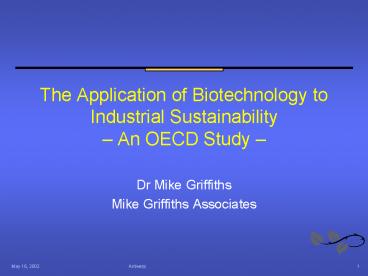The Application of Biotechnology to Industrial Sustainability An OECD Study - PowerPoint PPT Presentation
1 / 26
Title:
The Application of Biotechnology to Industrial Sustainability An OECD Study
Description:
'The Application of Biotechnology to Industrial Sustainability' (OECD, 2001) ... demonstrate the sustainability of their company. Policy makers within government ... – PowerPoint PPT presentation
Number of Views:326
Avg rating:3.0/5.0
Title: The Application of Biotechnology to Industrial Sustainability An OECD Study
1
The Application of Biotechnology to Industrial
Sustainability An OECD Study
- Dr Mike Griffiths
- Mike Griffiths Associates
2
OECD Publications
- Biotechnology for Clean Industrial Products and
Processes (OECD, 1998) - The Application of Biotechnology to Industrial
Sustainability (OECD, 2001) - http//www.oecd.org/bookshop for both
reports
3
Unanswered Questions
- Some assessments already existed but were -
- academic studies of environmental problems
- specific in-house analyses of process development
- We wanted to know
- Can biotechnology provide a cheaper option?
- Can economic and environmental improvement go
hand in hand?
4
Why the latest study?
- No collections of comparable case studies
existed, and - No analysis to-date of the policy implications
- Why did we do it?
- Biotech should be on every industrial agenda
- Sustainability on every list of parameters
5
Basis of the Study
- Companies which have adopted new biotechnology
processes (21 case studies) - The factors in their decision making
- The policy lessons which emerged
- Sponsors the Canadian and UK governments
6
Two distinct audiences
- Industrial policy makers (senior management)
- show what others have done and the benefits
- demonstrate the sustainability of their company
- Policy makers within government
- see how the early adopters have made decisions
- support guidelines for national financing
programmes
7
The triple bottom line
Size of triangle indicator of sustainability
8
One Companys Vision
9
Applications of biotechnology 1
- Replacement of fossil fuels by renewable raw
materials, for example - Cargill Dow polymers - polylactides
- Eastman and Genencor - ascorbic acid
- DuPont and Genencor - 1,3-propanediol
- Biofuels - bioethanol, biodiesel
10
DuPont Bioproducts
11
Applications of biotechnology 2
- Industrial use of biological systems (whole
cells, enzymes) - Waste recycling
- Chiral synthesis
- Textile treatment
- Oil well completion
- etc., etc.
12
Production of 7-amino cephalosporanic acid
Waste to be incinerated
I t 7-ACA
Enzymatic Process
Old Chemical Process
0.3 t
31 t
13
Breakdown of cases by sector and country
14
Participating Companies
- Avecia
- Baxenden
- Billiton
- Biochemie (Novartis)
- Cargill Dow
- Cereol
- Ciba
- Domtar
- DSM
- ICPET
- Iogen
- Leykam
- M-I, BP Amoco
- Mitsubishi Rayon
- Oji Paper
- Paques (Budel Zink, Pasfrost
- Roche
- Tanabe Seiyaku
- Windel
15
Experience curve for Penicillin G price
1965
1970
1975
1980
Absolute price (in year 2000 's/kg)
1985
1995
1990
1999
2010
Cumulated volumes (MT)
16
Lewis Carroll in Alice through the
Looking-Glass
- A slow sort of country! said the Queen. Now,
here, you see, it takes all the running you can
do, to keep in the same place. If you want to get
somewhere else, you must run at least twice as
fast as that.
17
Preimplementation stages
- Getting an idea
- Putting biotech on the boards agenda
- Deciding on parameters to measure and
- Assembling the data
- Looking into the future
- Proceed or not
18
Technologies for the Future
19
Life Cycle Assessment
- Answering the questions
- Does process reduce environmental load or merely
transfer it up - or downstream? - Where in the process is the most severe
environmental impact? - Quantifying comparisons of alternative process
options and competing technologies
20
Acrylamide processes - energy consumption
7
6
5
Raw Materials
4
Energy Consumption MJ / kg-AAm
Electric Power
3
2
Steam
1
0
Catalytic Process
Enzymatic New-Process
Enzymatic Old - Process
21
Bioextraction of Copper
22
Significant findings 1
- Biotech invariably led to a more environmentally
friendly process - It also resulted in a cheaper process
- but
- The role of the environment was secondary to
cost and product quality - unless
- Environmental legislation is driving -
- then the decision might be clean up or close!
23
Significant findings 2
- Approaches were rarely systematic - so follow
your hunch - Biotech skills had to be acquired - do you need
industrial or academic partners - Lead times improved with succeeding developments
24
Costs and environmental benefits
Case
Energy
Raw
Waste to air
Waste to
Operating
materials
water
costs
a.
Same
-75 (non-
-50
-66
-50
renewables)
b.
Elec.
-80
-80
considerable
Steam -
reduction
c.
-80
down
down
down
d.
down
down
down
-54 (raw
materials)
e.
-70
-80
-40
f.
-15
Down (clean
down
-9
water)
25
Enzyme de-gumming of vegetable oil
26
Messages
- Why adopt biotechnology? To improve costs and be
environmentally friendly - Be aware of change, find yourself an R D
partner - Have a champion, assemble arguments to convince
doubters - Build your own inhouse biotech skill base
- Companies work with government and keep close
to the regulators - Government there is much help the companies
still need especially R D funding - Do you know of any good examples we can use?































